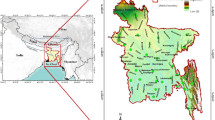Abstract
A statistical model for the formation of climate-related hazards is proposed. The formation is described by several meteorological variables or applied climatic indices characterizing a calendar year. Their values or data for their calculation are provided by climate monitoring systems. A climate-related hazard arises when these variables or applied climate indices together go beyond their safe ranges over substantial number of several consecutive years. Respective minimum values for the number of such years are substantiated for different levels of the likelihood of occurrence of a climate-related hazard. The developed methodology was applied to obtain probabilistic estimates of the climatic range of the tick Ixodes ricinus (Linnaeus, 1758), a vector of dangerous human diseases, and its changes in 2001–2010 as compared to 1971–1980. The results are presented in the form of schematic maps.


Similar content being viewed by others
REFERENCES
Report on Climate Features in the Russian Federation in 2018 (Roshydromet, Moscow, 2019) [in Russian].
P. H. Muller, P. Neumann, and R. Storm, Tafeln der Mathematischen Statistik (Finansy i Statistika, Moscow, 1982) [Transl. from German].
E. P. Odum,Basic Ecology, Vol. 2 (Mir, Moscow, 1986) [Transl. from English].
Paris Agreement (The United Nations, 2015), https://unfccc.int/sites/default/files/russian_paris_agre-ement.pdf (Accessed on January 27, 2020) [in Russian].
I. O. Popov,Climate-related Changes in Autecological Ranges of Ticks Ixodes ricinus and Ixodes persulcatus on the Territory of Russia and Near-abroad Countries, Abstract of Candidate’s Thesis in Biology (Moscow, 2016) [in Russian].
E. N. Popova and I. O. Popov, “Modeling of Potential Climatic Ranges of Biological Species and Their Climate-driven Changes,” Fundamental’naya i Prikladnaya Klimatologiya, No. 1 (2019) [in Russian].
S. M. Semenov, V. V. Yasyukevich, and E. S. Gel’ver, Revelation of Climate-related Changes (Meteorologiya i Gidrologiya, Moscow, 2006) [in Russian].
Taiga Tick Ixodes persulcatus Schulze (Acarina, Ixodidae): Morphology, Systematics, Ecology, Medical Value, Ed. by N. A. Filippova (Nauka, Leningrad, 1985) [in Russian].
V. V. Yasyukevich, E. V. Kazakova, I. O. Popov, and S. M. Semenov, “Distribution of Ixodes ricinus L., 1758 and Ixodes persulcatus Shulze, 1930 (Parasitiformes, Ixodidae) in Russia and Adjacent Countries in View of Observable Climate Changes,” Dokl. Akad. Nauk, No. 5, 427 (2009) [Dokl. Earth Sci., No. 6, 427 (2009)].
I. Harris, P. Jones, T. Osborn, and D. Lister, “Updated High Resolution Grids of Monthly Climatic Observations: The CRU TS3.10 Dataset,” Int. J. Climatol., 34 (2014).
IPCC, 2018. Global Warming of 1.5°C. An IPCC Special Report on the Impacts of Global Warming of 1.5°C above Pre-industrial Levels and Related Global Greenhouse Gas Emission Pathways, in the Context of Strengthening the Global Response to the Threat of Climate Change, Sustainable Development, and Efforts to Eradicate Poverty (2018), http://report.ipcc.ch/sr15/.
IPCC, Climate Change and Land: An IPCC Special Report on Climate Change, Desertification, Land Degradations, Sustainable Land Management, Food Security, and Greenhouse Gas Fluxes in Terrestrial Ecosystems (2019), https://www.ipcc.ch/srccl-report-download-page/.
IPCC Special Report on the Ocean and Cryosphere in a Changing Climate, Ed. by H.-O. Portner, D. C. Roberts, V. Masson-Delmotte, P. Zhai, M. Tignor, E. Poloczanska, K. Mintenbeck, M. Nicolai, A. Okem, J. Petzold, B. Rama, and N. Weyer (2019), https://www.ipcc.ch/srocc/download-report/.
M. D. Mastrandrea, C. B. Field, T. F. Stocker, O. Edenhofer, K. L. Ebi, D. J. Frame, H. Held, E. Kriegler, K. J. Mach, P. R. Matschoss, G.-K. Plattner, G. W. Yohe, and F. W. Zwiers, “Guidance Note for Lead Authors of the IPCC Fifth Assessment Report on Consistent Treatment of Uncertainties,”IPCC Cross-working Group Meeting on Consistent Treatment of Uncertainties, Jasper Ridge, CA, USA, July 6–7, 2010, Intergovernmental Panel on Climate Change (IPCC) (2010), http://www.ipcc.ch.
S. J. Swanson, D. Neitzel, K. D. Reed, and E. A. Belongia, “Coinfections Acquired from Ixodes Ticks,” Clin. Microbiol. Rev., No. 4, 19 (2006).
Author information
Authors and Affiliations
Corresponding author
Additional information
Russian Text ©The Author(s), 2020, published in Meteorologiya i Gidrologiya, 2020, No. 5, pp. 59–65.
About this article
Cite this article
Semenov, S.M., Popov, I.O. & Yasyukevich, V.V. Statistical Model for Assessing the Formation of Climate-related Hazards Based on Climate Monitoring Data. Russ. Meteorol. Hydrol. 45, 339–344 (2020). https://doi.org/10.3103/S1068373920050040
Received:
Revised:
Accepted:
Published:
Issue Date:
DOI: https://doi.org/10.3103/S1068373920050040




